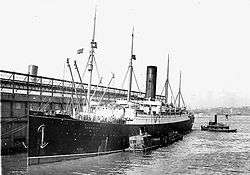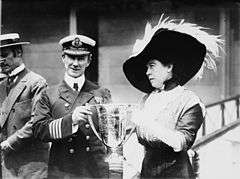RMS Carpathia
 RMS Carpathia | |
| History | |
|---|---|
| Name: | RMS Carpathia |
| Owner: | Cunard Line |
| Route: |
|
| Builder: | Swan Hunter & Wigham Richardson |
| Laid down: | 10 September 1901 |
| Launched: | 6 August 1902 |
| Maiden voyage: | 5 May 1903 |
| In service: | 1903–1918 |
| Fate: | Torpedoed southeast of Ireland and west of the Isles of Scilly by German submarine U-55, 17 July 1918 |
| General characteristics | |
| Class and type: | Cunard Line transatlantic passenger steamship |
| Type: | Ocean liner |
| Tonnage: | 13,555 gt |
| Displacement: | 8,600 long tons (8,700 t) |
| Length: | 558 ft (170 m) |
| Beam: | 64 ft 6 in (19.66 m) |
| Draught: | 34 ft 7 in (10.54 m) |
| Propulsion: |
|
| Speed: |
|
| Capacity: |
|
RMS Carpathia was a Cunard Line transatlantic passenger steamship built by Swan Hunter & Wigham Richardson.
Carpathia made her maiden voyage in 1903 and became famous for rescuing the survivors of rival White Star Line's RMS Titanic after it struck an iceberg and sank with a loss of 1,517 lives on 15 April 1912; Carpathia braved dangerous ice fields and diverted all steam power to her engines in her attempt to aid the ship, but arrived two hours after Titanic had sunk; nevertheless, she was able to rescue 705 survivors from the ship's lifeboats. Carpathia herself met her fate in the Atlantic on 17 July 1918 during the First World War after being torpedoed by the German submarine U-55 off the Irish coast. Five of her crew lost their lives in the sinking.
History
Building and early service
RMS Carpathia was built by Swan Hunter & Wigham Richardson at their Newcastle upon Tyne, England shipyard. She was launched on 6 August 1902 and underwent her sea trials between 22 and 25 April 1903. Carpathia displaced 8,600 long tons (8,700 t) and was 541 ft (165 m) long and 64 ft 6 in (19.66 m) breadth.
Carpathia made her maiden voyage on 5 May 1903 from Liverpool, England, to Boston, USA, and ran services between New York City, Gibraltar, Genoa, Naples, Trieste and Fiume.
Titanic disaster

Carpathia was sailing from New York City to Fiume, Austria-Hungary (now Rijeka, Croatia) on the night of Sunday, 14 April 1912. Among its passengers were the American painters Colin Campbell Cooper and his wife Emma, author Philip Mauro, journalists Lewis Palmer Skidmore and Carlos Fayette Hurd, with their wives, Emily Vinton Skidmore and Katherine Cordell Hurd, photographer Dr. Francis H. Blackmarr, and Charles H. Marshall, whose three nieces were travelling aboard Titanic. Also on board were Hope Brown Chapin, honeymooning youngest daughter of former governor of Rhode Island, Russell Brown, Pittsburgh architect Charles M. Hutchison and wife, Sue Eva Rule, sister of Judge Virgil Rule of the St. Louis court of appeals, as well as Louis Mansfield Ogden, Esq., with his wife, Augusta Davies Ogden, a granddaughter of Alexander H. Rice.
Carpathia's wireless operator, Harold Cottam, had missed previous messages from the Titanic, as he was on the bridge at the time.[1] He then received messages from Cape Race, Newfoundland, stating they had private traffic for Titanic. He thought he would be helpful and at 12:11 a.m. on 15 April sent a message to Titanic stating that Cape Race had traffic for them. In reply he received Titanic's distress signal.[1] Cottam awakened Captain Arthur Henry Rostron, who immediately checked the ship's position which he calculated as 41° 10' N, 49° 12' W. Rostron ordered a course at maximum speed (17 kn (20 mph; 31 km/h)) to Titanic's last known position, approximately 58 mi (93 km) away.
Rostron ordered the ship's heating and hot water cut off in order to make as much steam as possible available for the engines, succeeding in going 3.5 knots faster than the ship's rated top speed (a speed it would never reach again in its career).[2] At full speed it took the Carpathia four hours to reach Titanic, while Titanic only stayed afloat for two hours and sank before Carpathia arrived, claiming the lives of 1,517 of the "Titanic" passengers and crew. At 4:00 a.m., Carpathia arrived at the scene, after working her way through dangerous ice fields, and took on 705 survivors of the disaster from Titanic's lifeboats.[1] By 9:00, the last survivor had been picked up, and Rostron gave the order to depart for New York. Carpathia arrived in port on 18 April.

For their rescue work, the crew of Carpathia were awarded medals by the survivors. Crew members were awarded bronze medals, officers silver, and Captain Rostron a silver cup and a gold medal, presented by Margaret Brown. Rostron was knighted by King George V, was later a guest of President Taft at the White House, where he was presented with a Congressional Gold Medal, the highest honour the United States Congress could confer upon him.
Service in World War I
During the First World War, Carpathia was used to transfer Canadian and American troops to Europe. She was used as a troopship by the Canadian Expeditionary Force.[3] At least some of her voyages were in convoy, sailing from New York through Halifax to Liverpool and Glasgow.[4] Among her passengers during the war years was Frank Buckles, who went on to become the last surviving American veteran of the war.
Sinking

On 15 July 1918, Carpathia departed Liverpool in a convoy bound for Boston. On the summer morning of 17 July she was torpedoed, at 9:15, in the Celtic Sea by the German submarine U-55. Of the two torpedoes initially fired at the ship, one impacted the port side while the other penetrated the engine room, killing three firemen and two trimmers.[5] As Carpathia began to settle by the head and list to port, Captain William Prothero gave the order to abandon ship. All 57 passengers (36 saloon class and 21 steerage) and the surviving crew members boarded the lifeboats as the vessel sank.[5] There were a total of 218 survivors.[5] U-55 surfaced and fired a third torpedo into the ship and was approaching the lifeboats when the Azalea-class sloop HMS Snowdrop arrived on the scene and drove away the submarine with gunfire before picking up the survivors from Carpathia.
Carpathia sank at 11:00 AM at a position recorded by Snowdrop as 49.25 N 10.25 W, approximately 120 mi (190 km) west of Fastnet.
Finding and salvage works
On 9 September 1999, the Reuters and AP wire services reported that Argosy International Ltd., headed by Graham Jessop, son of the undersea explorer Keith Jessop, and sponsored by the National Underwater and Marine Agency (NUMA), had discovered Carpathia's wreck in 600 ft (180 m) of water, 185 mi (298 km) west of Land's End.[6] Bad weather forced his ship to abandon the position before Jessop could verify the discovery using underwater cameras. However, when he later returned to the location the wreck proved to be not that of Carpathia but that of the Hamburg-America Line's Isis, sunk on 8 November 1936.[7]
In 2000, the American author and diver Clive Cussler announced that his organisation, NUMA, had found the true wreck of Carpathia in the spring of that year,[8][9] at a depth of 500 ft (150 m).[10] After the submarine attack Carpathia landed upright on the seabed. NUMA gave the approximate location of the wreck as 120 mi (190 km) west of Fastnet, Ireland.[11]
The vessel is currently owned by Premier Exhibitions Inc., formerly RMS Titanic Inc., which plans to recover objects from the wreck.[10] The same company owns the salvor-in-possession rights of RMS Titanic.
Gallery
 The grey-painted hull of Carpathia rests on the slipway, awaiting launch.
The grey-painted hull of Carpathia rests on the slipway, awaiting launch. Carpathia docked in New York following the rescue of Titanic's survivors
Carpathia docked in New York following the rescue of Titanic's survivors Margaret Brown (right) giving Captain Arthur Henry Rostron an award for his service in the rescue of the Titanic's survivors
Margaret Brown (right) giving Captain Arthur Henry Rostron an award for his service in the rescue of the Titanic's survivors- Rare on-deck photo of Carpathia passengers (circa 1914) unconnected with the Titanic disaster.
 Life boat card
Life boat card
See also
- SS Californian, another vessel that was involved with the Titanic and perished in World War I.
References
- 1 2 3 "Titanic Inquiry Project". Electronic copies of the inquiries into the disaster. Titanic Inquiry Project. 2007. Retrieved 27 April 2011.
- ↑ "RMS Carpathia" Retrieved 8 May 2014
- ↑ Official war diaries of CEF – 27 Batt. 15 May 1915
- ↑ Simmons, Perez; H. Davies, Alfred. Twentieth Engineers – France – 1917–1918–1919 (PDF). Portland, Oregon: Dimm & Sons Printing Co. Twentieth Engineers Publishing Association. Retrieved 18 April 2012.
- 1 2 3 "Carpathia sunk; 5 of crew killed;", New York Times, p. 4, July 20, 1918
- ↑ "UK Titanic rescue ship 'found'". BBC News. September 8, 1999.
- ↑ Cussler, Clive; Delgado, James P. (2004). Adventures of a Sea Hunter: In Search of Famous Shipwrecks. Douglas & McIntyre. p. 85. ISBN 978-1-55365-071-3.
- ↑ "Wreck of the Carpathia, Titanic's Rescuer, Found". National Underwater and Marine Agency. 2004-04-27. Archived from the original on 2004-04-27. Retrieved 2015-06-26.
- ↑ Reuters (23 September 2000). "Discovery Of R.M.S. Carpathia". Titanic-Titanic.com. Retrieved 26 August 2007.
- 1 2 BBC News. "Dive to film Titanic rescue ship". Retrieved 26 August 2007.
- ↑ "Carpathia Rescue". National Underwater and Marine Agency. 2004-02-25. Archived from the original on 2004-02-25. Retrieved 2015-06-26.
Further reading
- Butler, Daniel Allen. (2009). The Other Side of the Night: The Carpathia, the Californian, and the Night the Titanic Was Lost. Philadelphia: Casemate.
- Eaton, John P. and Haas, Charles A. (1995). Titanic: Triumph and Tragedy. New York: W. W. Norton & Compan., 2nd ed.
External links
| Wikimedia Commons has media related to Carpathia (ship, 1903). |
- Carpathia on thegreatoceanliners.com
- Biography of Captain Rostron
- RMS Carpathia at sorbie.net
- RMS Carpathia official page on Facebook
- BBC News video describing a diving exploration of the ship
Coordinates: 49°28′00″N 19°46′00″W / 49.4667°N 19.7667°W